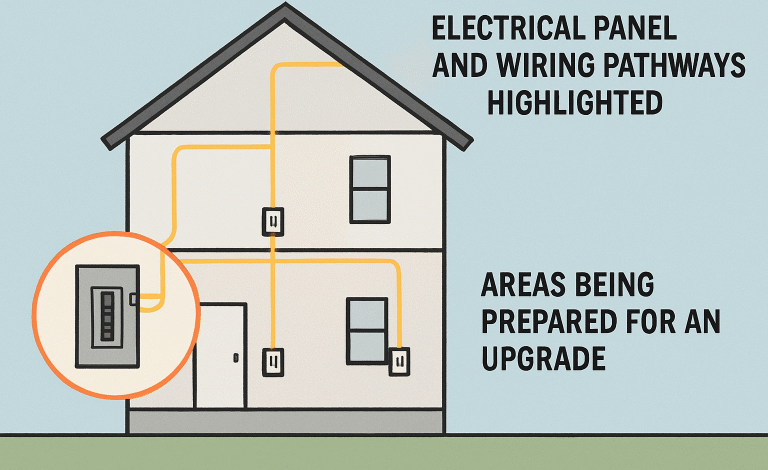How to Prepare Your Home for Electrical Upgrades

Upgrading your electrical system is one of the most worthwhile improvements you can make to your home, especially if safety or future-proofing is a priority. Whether modernizing an older property or ensuring your house can handle the demands of new technology, a careful approach is essential. Consulting a certified professional, like a Greenville SC electrical contractor, ensures the process is completed safely, efficiently, and according to all relevant codes and standards. Proper preparation streamlines the upgrade and helps you avoid costly mistakes and unexpected interruptions along the way.
Knowing how to prepare your home step-by-step makes the electrical upgrade process less stressful and more predictable for you and your licensed electrician. Here’s a comprehensive guide to make your project successful from the planning stage through the final inspection.
Assess Your Current Electrical System
Start by thoroughly evaluating your existing electrical infrastructure. Older homes, in particular, may exhibit signs that an upgrade is needed, such as fuses instead of breakers, repeated breaker trips, flickering or dimming lights, sparks from outlets, or noticeably warm wall plates. These symptoms often indicate that your system struggles to meet your household’s demands or might be unsafe.
If your electrical panel is over 25 years old or you have ungrounded outlets, it’s time for a professional evaluation even if you haven’t noticed obvious warning signs yet. Identifying these risks beforehand lets you first prioritize repairs and replacements for critical components.
Plan for Future Electrical Demands
Thinking ahead is critical when it comes to electrical upgrades. More households are installing high-draw appliances, electric vehicle chargers, home offices, and smart devices that can quickly overwhelm an older electrical system. Review your lifestyle, upcoming remodels, and any technology upgrades you anticipate in the next 5–10 years.
Upgrading your panel or wiring now to accommodate future needs can help prevent additional messy, disruptive electrical work later. Ask your electrician about adding circuits, installing more outlets, and upgrading wiring to support future needs efficiently.
Hire a Licensed Electrician
Electrical upgrades are not DIY projects—the risks can be severe, including fire, injury, or code violations leading to failed inspections. Always hire a licensed and insured electrician who understands current local code requirements. A professional can diagnose system deficiencies, estimate future power requirements, and develop a tailored plan for your home.
Check credentials, review past client testimonials, and ensure your contractor provides detailed written estimates. Clear communication and a written scope of work help prevent misunderstandings during the upgrade.
Obtain Necessary Permits and Schedule Inspections
Most major electrical upgrades, such as panel replacements or significant rewiring, require permits from your local building department. Your electrician should handle permitting and ensure all work is inspected appropriately. Failure to get permits may lead to costly redos or code violations that affect your home’s resale value or insurance eligibility.
Expect at least two inspections: one after rough-in work (before new walls or ceilings are sealed) and a final after everything is complete. Inspections ensure all electrical work meets local safety codes and standards before you start using your upgraded system.
Prepare Your Home for the Upgrade
Clear and Protect Work Areas
Before the electrician arrives, clear pathways and access to electrical panels, outlets, and other work areas. Move furnishings, rugs, or fragile items out of the way, and use plastic sheeting or drop cloths to protect flooring and furniture from dust or debris created during installation.
Minimize Disruptions
Any major electrical project will involve power shutoffs. Charge your phones and laptops beforehand, and have battery-powered lights available. If the work is extensive, consider making alternate arrangements for critical routines that depend on electricity, primarily if you work from home or have special medical equipment.
Understand the Upgrade Process
Upgrades typically follow several steps, which may include:
- Disconnecting power to specific areas to ensure safety.
- Installing new electrical panels or subpanels to handle increased capacity.
- Running new wiring, adding circuits, or installing new outlets and switches.
- Testing all new installations to ensure everything is safe and operational.
Your electrician will inform you when power needs to be shut off and how long disruptions may last. Familiarizing yourself with the workflow helps set expectations and reduces stress for everyone involved.
Post-Upgrade Inspection and Documentation
After work is completed, conduct a walkthrough with your electrician to double-check outlets, switches, and other fixtures. Ensure you receive copies of your permit approval, final inspection report, and proof of work for your records; you may need these if you sell your home or file a warranty claim.
Systematic preparation at every stage—from initial assessment to documentation—ensures that your electrical upgrade is a wise, safe investment that enhances your home’s value and your family’s peace of mind.



